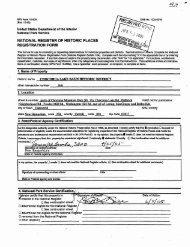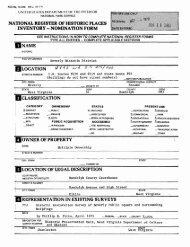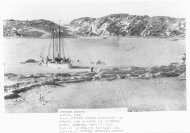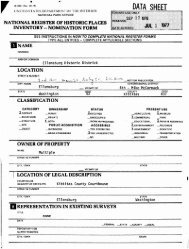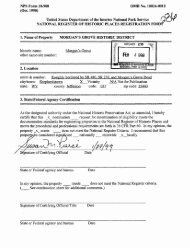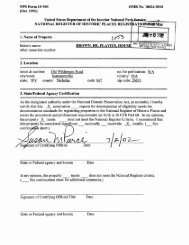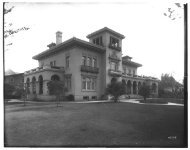National Register of Historic Places Registration Form
National Register of Historic Places Registration Form
National Register of Historic Places Registration Form
Create successful ePaper yourself
Turn your PDF publications into a flip-book with our unique Google optimized e-Paper software.
NFS <strong>Form</strong> 10-90O-8 OMB Approval No. 1024-0018<br />
(M6)<br />
United States Department <strong>of</strong> the Interior<br />
<strong>National</strong> Park Service<br />
<strong>National</strong> <strong>Register</strong> <strong>of</strong> <strong>Historic</strong> <strong>Places</strong><br />
Continuation Sheet<br />
CLEVELAND PARK HISTORIC DISTRICT<br />
WASHINGTON D.C.<br />
Section number 8 page _§_____<br />
single family dwellings, <strong>of</strong> varying sizes, set in generous natural<br />
surroundings.<br />
Cleveland Park's commercial area along Connecticut Avenue is also unique<br />
in Washington D.C. It embodies an intact example <strong>of</strong> enlightened planning for<br />
a neighborhood shopping area which was the goal <strong>of</strong> the 1920 Zoning Law, one <strong>of</strong><br />
the earliest adopted in the U.S. This area represents a concentration <strong>of</strong><br />
commercial structures dating from 1925 to 1939 reflecting changing attitudes<br />
in community planning and development largely in response to the increased use<br />
<strong>of</strong> the automobile and changing trends in architectural styles. It contains<br />
within it the earliest known prototype shopping center in Washington D.C.,<br />
possibly the earliest on the East Coast. Together with the residences the<br />
commercial area exemplifies the continuous line <strong>of</strong> development <strong>of</strong> a successful<br />
residential community from 1894 to 1941. The initial success <strong>of</strong> the Cleveland<br />
Park neighborhood prompted the establishment <strong>of</strong> apartment buildings and small<br />
shops along Connecticut and Wisconsin avenues which consequently led to the<br />
construction <strong>of</strong> additional houses and apartment buildings. The history <strong>of</strong> the<br />
two areas - the residential side streets and the main traffic arteries from<br />
the city -are inextricably linked.<br />
Cleveland Park is distinguished from the later automobile-related<br />
suburbs situated to the north which are more sprawling and less oriented<br />
toward a commercial center along the avenues. They generally lack the<br />
cohesiveness as identifiable communities which is one <strong>of</strong> the distinguishing<br />
features <strong>of</strong> Cleveland Park. It is also distinguished from Woodley Park,<br />
situated to the south, which has more townhouses, fewer large front yards,<br />
fewer hills, and a predominance <strong>of</strong> brick architecture all <strong>of</strong> which give it a<br />
more urban atmosphere. The core <strong>of</strong> late Victorian houses in Cleveland Park<br />
predates the architecture in communities to the north, south and west and is<br />
separated from communities to the east by the geography <strong>of</strong> Rock Creek Park<br />
which originally made this area inaccessible.



